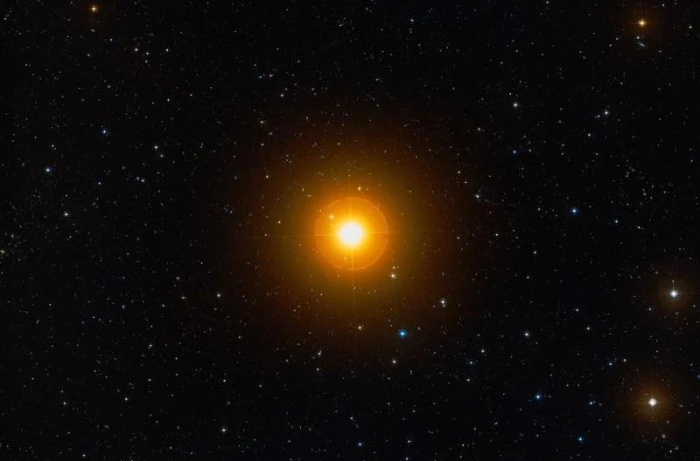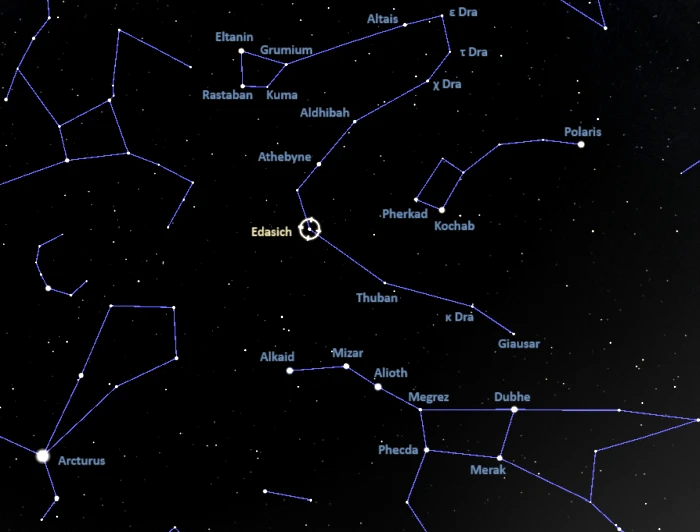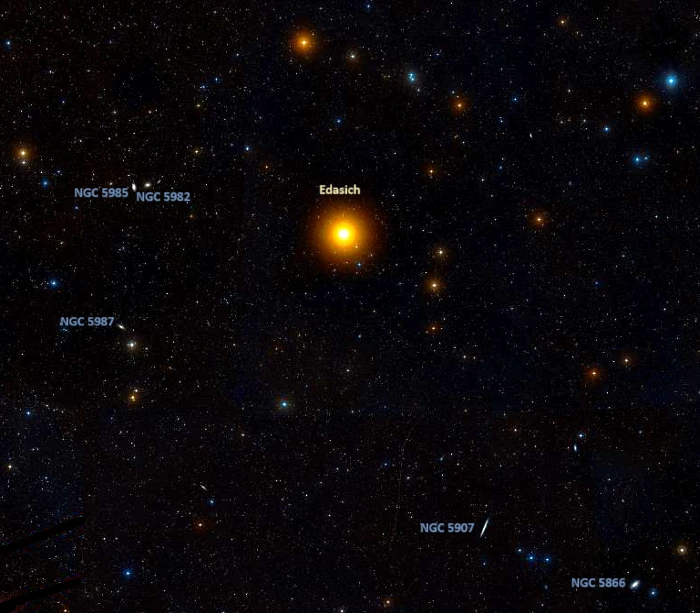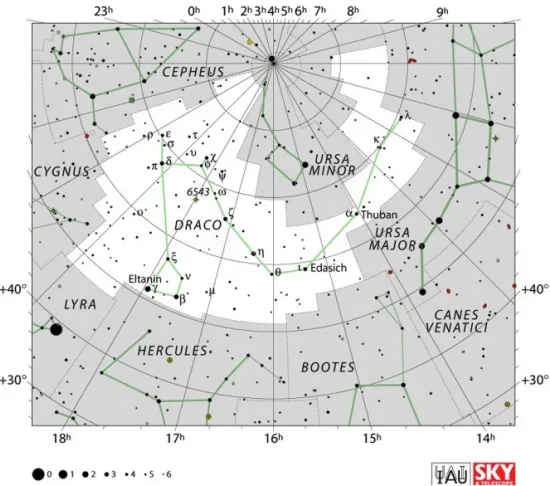Edasich, Iota Draconis (ι Dra), is an orange giant star located approximately 101.2 light-years away in the northern constellation of Draco. With an apparent magnitude of 3.290, it is the sixth brightest star in Draco. It hosts two orbiting exoplanets, Iota Draconis b (Hypatia) and Iota Draconis c, discovered in 2002 and 2021.
Star type
Edasich is an evolved star on the red giant branch. It has the spectral type K2III. The star is larger and more massive than the Sun, with a mass of 1.56 solar masses and a radius of 11.99 solar radii. With an effective temperature of 4,504 K, it is 52.8 times more luminous than the Sun.
Iota Draconis is a relatively slow spinner. With a projected rotational velocity of 1.5 km/s, it takes 434 days to complete a rotation. The star is much younger than the Sun. It has an estimated age of 2.49 billion years. It evolved away from the main sequence faster than the Sun because it is more massive.
Edasich likely started its main sequence life as an A-type star with an effective temperature of 7,400 – 10,000 K. As it left the main sequence, it cooled while expanding to its current size.
The star was once listed as a suspected variable. However, its brightness has been found to be constant to within 0.004 magnitudes.
Edasich shows an excess emission in the infrared, which indicates the presence of a circumstellar disk of dust. Debris disks are typically detected around stars with mature planetary systems.
The star has a line-of-sight companion, a ninth magnitude star at a separation of about 4 arcminutes.

Edasich (Iota Draconis), image credit: ESO/Digitized Sky Survey 2 (CC BY 4.0)
Planets
Iota Draconis hosts two planets. The first, Iota Draconis b, was discovered by a team led by Sabine Frink, Center for Astrophysics and Space Sciences, University of California, San Diego, during a radial velocity study of K-type giants in 2002. The super-Jupiter was formally named Hypatia, after the Greek astronomer, mathematician and philosopher Hypatia (c. 350-370 – 415 CE), in December 2015. The name was proposed by the Hypatia student society at the Physics Faculty of the Universidad Complutense de Madrid, Spain.
Iota Draconis b (Edasich b) was the first planet discovered in orbit around a giant star. The host star’s habitable zone is in the range between 6.8 and 13.5 astronomical units (Earth – Sun distances). The planet orbits at a distance of 1.34 AU, which means that it is too close to the star for liquid water to form on its surface. The habitable zone boundaries were obtained in a 2011 study based on observations with the Center for High Angular Resolution Astronomy (CHARA) array interferometer.
The planet has an orbital period of 1.398643 years (510.854 days). Its highly eccentric orbit makes it highly unlikely that there are any inner planets orbiting the star.
In 2021, astronomers determined the mass of Iota Draconis b to be 16.4 times the mass of Jupiter. They found a minimum mass of 11.82 Jupiter masses.
The second substellar companion, Iota Draconis c, was discovered by a team of astronomers led by Michelle H. Hill, Department of Earth and Planetary Sciences, University of California, Riverside, in 2021. The long-period companion has an orbital period of around 68 years and is either a planet or a brown dwarf. The candidate planet has a mass of around 17 Jupiter masses and orbits the parent star at a distance of 19.4 AU.
Name
The name Edasich (pronunciation: /ˈɛdəsɪk/) was derived from the Arabic Al Ḍhiba’, Al Dhih, or Al dhīlī, meaning “the male hyena.” The variation Eldsich was recorded in the Century Cyclopedia in the 19th century.
The International Astronomical Union’s (IAU) Working Group on Star Names (WGSN) approved the name Edasich for Iota Draconis on December 15, 2015.
In traditional Chinese astronomy, Edasich was known as 紫微左垣一 (Zǐ Wēi Zuǒ Yuán yī), the First Star of Left Wall of Purple Forbidden Enclosure. It formed the Left Wall asterism with Theta Draconis, Athebyne (Eta Draconis), Aldhibah (Zeta Draconis), Upsilon Draconis, 73 Draconis, Pi Cephei, and 23 Cassiopeiae. The asterism represented eight guardian stars and was part of the larger Purple Forbidden Enclosure, which represented the imperial palace. Iota Draconis represented 左樞 (Zuǒshū), the Left Pivot.
Location
Edasich lies in the region between the Dragon’s head, formed by Eltanin, Rastaban, Grumium and Kuma, and the handle of the Big Dipper in Ursa Major. It is the brightest star along the imaginary line connecting the brighter Athebyne in Draco and Alkaid at the tip of the Great Bear’s tail.
Athebyne can be found by extending a line from Kochab through Pherkad, the outer stars of the Little Dipper’s bowl. Known as the Guardians of the Pole, these stars appear parallel to Alioth and Mizar in the Big Dipper’s handle.

The location of Edasich (Iota Draconis), image: Stellarium
Iota Draconis can be used to find several relatively bright galaxies, including the Spindle Galaxy (NGC 5866, Messier 102), the Splinter Galaxy (NGC 5907), NGC 5982, NGC 5985, and NGC 5987.
At declination +59°, Edasich is best seen from the northern hemisphere. It never rises for observers south of the latitude 31° S.

Galaxies near Edasich (Iota Draconis), image credit: ESO/Digitized Sky Survey 2 (CC BY 4.0)
Constellation
Edasich is located in the constellation Draco. Representing the dragon Ladon in Greek mythology, Draco is one of the oldest and largest constellations in the sky. It is one of the northernmost constellations, along with Ursa Minor, Cepheus, and Camelopardalis. Northern observers can see it twisting around Polaris and the Little Dipper throughout the year.
Draco was one of the 48 ancient constellations catalogued by Claudius Ptolemy of Alexandria in the 2nd century AD. The modern constellation stretches across 1,083 square degrees of the northern sky and is the eighth largest of the 88 constellations.
Despite its size, Draco is not particularly conspicuous. It contains only three stars brighter than magnitude 3.0. The constellation’s lucida, the orange giant Eltanin (Gamma Draconis), shines at magnitude 2.23.

Draco constellation map by IAU and Sky&Telescope magazine (Roger Sinnott & Rick Fienberg) (CC BY 3.0)
Other relatively bright stars in Draco include the yellow giants Athebyne (Eta Draconis) and Altais (Delta Draconis), the yellow supergiant or bright giant Rastaban (Beta Draconis), the hot blue giant Aldhibah (Zeta Draconis), the orange giant Grumium (Xi Draconis), the white giant Thuban (Alpha Draconis), and the multiple star systems Nu Draconis (Kuma) and Mu Draconis (Alrakis).
Deep sky objects in Draco include the Spindle Galaxy (Messier 102, NGC 5866), the Splinter Galaxy (NGC 5907), the interacting galaxies NGC 6622, the Dolphin Galaxy (NGC 6670), the Tadpole Galaxy (Arp 188), the Draco Trio, NGC 6285 and NGC 6286, and the planetary nebulae Abell 50 (NGC 6742) and the Cat’s Eye Nebula (NGC 6543).
The best time of the year to observe the stars and deep sky objects in Draco is during the month of July, when the constellation appears higher in the sky in the early evening. The entire constellation is visible from locations north of the latitude 15° S.
The 10 brightest stars in Draco are Eltanin (Gamma Dra, mag. 2.23), Athebyne (Eta Dra, mag. 2.73), Rastaban (Beta Dra, mag. 2.79), Altais (Delta Dra, mag. 3.07), Aldhibah (Zeta Dra, mag. 3.17), Edasich (Iota Dra, mag. 3.29), Chi Draconis (mag. 3.57), Thuban (Alpha Dra, mag. 3.6452), Grumium (Xi Dra, mag. 3.75), and Giausar (Lambda Dra, mag. 3.85).
Edasich – Iota Draconis
| Spectral class | K2III |
| Variable type | Suspected variable |
| U-B colour index | +1.230 |
| B-V colour index | +1.160 |
| Apparent magnitude | 3.290 |
| Absolute magnitude | 0.99 ± 0.007 |
| Distance | 101.2 ± 0.3 light-years (31.03 ± 0.10 parsecs) |
| Parallax | 32.5239 ± 0.1310 mas |
| Radial velocity | -10.912 ± 0.0010 km/s |
| Proper motion | RA: -8.183 ± 0.166 mas/yr |
| Dec.: +17.08 ± 0.167 mas/yr | |
| Mass | 1.56 ± 0.08 M☉ |
| Luminosity | 52.8 ± 2.1 L☉ |
| Radius | 11.99 ± 0.06 R☉ |
| Temperature | 4,504 ± 62 K |
| Metallicity | +0.03 ± 0.08 dex |
| Age | 2.49 billion years (1.87 – 3.13 billion years) |
| Rotational velocity | 1.5 km/s |
| Rotation | 434 days |
| Surface gravity | 2.52 cgs (2.45 – 2.527 cgs) |
| Constellation | Draco |
| Right ascension | 15h 24m 55.7738042889s |
| Declination | +58° 57′ 57.837111857″ |
| Names and designations | Edasich, Eldsich, Iota Draconis, Iota Dra, ι Draconis, ι Dra, 12 Draconis, 12 Dra, HD 137759, HR 5744, HIP 75458, SAO 29529, FK5 425, FK5 571, NSV 7077, PLX 3490.00, GC 20747, GCRV 8925, SKY# 27902, PPM 34972, BD+59 1654, AG+59 999, PMC 90-93 405, ROT 2187, GEN# +1.00137759, GSC 03875-01620, IRC +60233, JP11 2606, N30 3475, TD1 18258, TIC 165722603, IRAS 15238+5908, 2MASS J15245578+5857577, TYC 3875-1620-1, Gaia DR2 1614731957530945280, Gaia DR3 1614731957531452544, UBV 13273, UBV M 20785, uvby98 100137759, WEB 12868, DO 34945, YZ 0 8366, BUP 162A, CCDM J15250+5859A, WDS J15249+5858A |